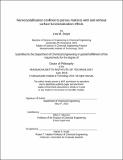Nanocrystallization confined to porous matrices with and without surface functionalization effects
Author(s)
Dwyer, Leia M.(Leia Mary)
Download1102783965-MIT.pdf (4.253Mb)
Other Contributors
Massachusetts Institute of Technology. Department of Chemical Engineering.
Advisor
Allan S. Myerson.
Terms of use
Metadata
Show full item recordAbstract
Poorly water-soluble active pharmaceutical ingredients (APIs), which represent a major fraction of the molecules in drug discovery and development, are a challenge to the pharmaceutical industry given their low bioavailability. One way to address this issue is to generate nanocrystals of these APIs. Nanocrystals have a significantly increased surface area to volume ratio as compared to standard micron-sized crystals, which results in improved solubility and dissolution rates. There already exist some industrially relevant techniques for producing pharmaceutical nanocrystals, which typically exploit contact forces and high pressures to bring crystals of a normal micron range down to the nanocrystal scale. However, these techniques are often plagued with challenges such as low production rates, high energy input, and issues with stabilization and control over the final crystalline form produced. Because of this, techniques which produce nanocrystals in the desired size range from the start are gaining interest. In this work, crystallization in confinement is used to produce stable pharmaceutical nanocrystals of a well-controlled size. Rigid, nanoporous silica matrices were used to confine crystallization volumes to the nanoscale, resulting in the formation of nanocrystals within these pores. The technique was demonstrated across a wide range of pore sizes, and using several poorly water-soluble APIs. When the principles were extended to a two-stage continuous crystallizer setup, the loadings of API in these porous matrices were improved to over 50 weight percent. When these drug loaded porous silicas were tested in a dissolution rate apparatus, the resulting dissolution profiles showed dramatic improvements as compared to the dissolution of bulk micron-sized crystals. In the later stages of this research, porous silica with surface functionalization was used rather than bare porous matrices. Herein, it was demonstrated that, at the small pore volumes present in these systems, the surface functionalization from the media may contribute enough functional group interaction to the solvent-solute system for the solubility of a dissolved API within these pores to change. Thus, through the combination of surface functionalization and confinement effects, this work demonstrated nanocrystallization from undersaturated API solutions using functionalized nanoporous matrices.
Description
This electronic version was submitted by the student author. The certified thesis is available in the Institute Archives and Special Collections. Thesis: Ph. D., Massachusetts Institute of Technology, Department of Chemical Engineering, 2018 Cataloged from student-submitted PDF version of thesis. Includes bibliographical references (pages 147-153).
Date issued
2018Department
Massachusetts Institute of Technology. Department of Chemical EngineeringPublisher
Massachusetts Institute of Technology
Keywords
Chemical Engineering.